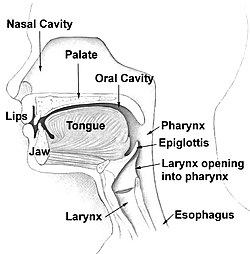Thethroat; a respiratory and digestive passageway from the oral and nasal cavities,and then to the esophagus and larynx (see figure below). It consists of circular muscles thatconstrict to aid food enter the esophagus while preventing air being inhaled,and longitudinal fibers that raise the walls of the pharynx duringswallowing. Both muscles are innervatedby the vagus nerve. It becomes evidentat about 4-5 weeks gestation in the human, and in all vertebrates it arisesfrom ‘outpocketings’ (viz. the pharyngeal arches). During chordate evolution it derives from thebrachial arches and gill slits of more ‘primitive’ forms.
